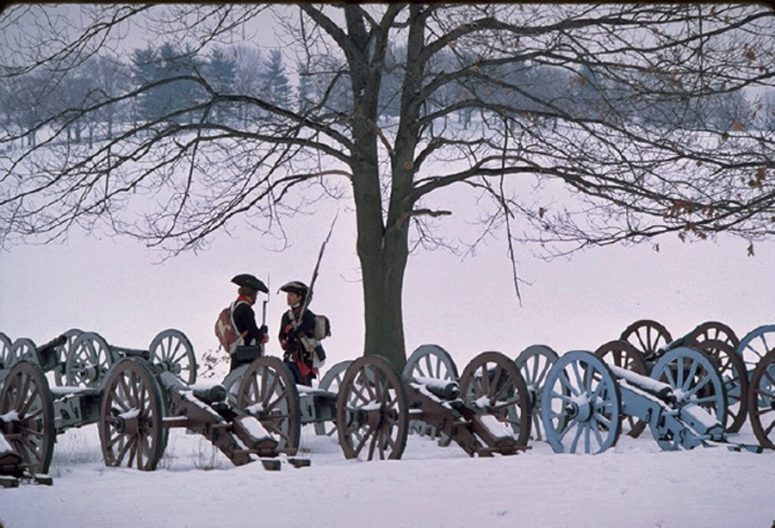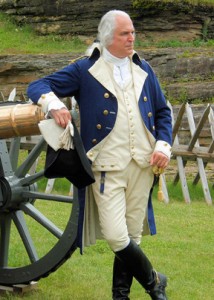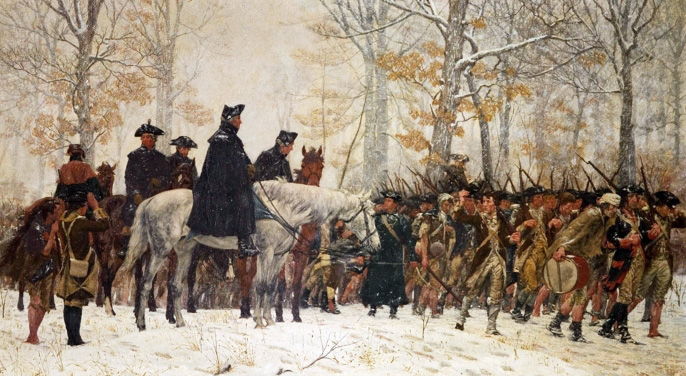
Just before Christmas, on the anniversary of George Washington’s encampment at Valley Forge, I trudged over frozen ground to the National Park to join a candlelight walking tour.
It’s a half-mile from the park entrance to the spot where the barracks were built. In 20-degree weather, this was a tough hike. But it forced me to imagine how grueling it must have been for the colonial soldiers who marched six miles from Gulph Mills to Valley Forge, uphill with equipment, in freezing weather in December of 1777.
I’ve been in the park for walking, bicycling and picnics. But this time I perceived it through a new prism, thanks to well-informed, costumed re-enactors, including a tall, magisterial General Washington look-alike (Dean Malissa, pictured below). Some of them serenaded us with Colonial-era Christmas carols and served apple cider at the end of the tour.
The experience gave me renewed admiration for the awesome achievement of Washington and his troops who camped there during the brutal winter of 1777-78. After the British occupied Philadelphia in the fall of 1777, Washington looked for a place to regroup and train his men. He selected Valley Forge, 18 miles northwest of Philadelphia. Its high ground, combined with the Schuylkill River to the north, made the area easily defensible. For further protection, he had a four-foot trench dug all the way around the camp.
Eleven thousand soldiers arrived on this plateau. Washington and a few of his officers lived in a previously existing stone building. The rest of their men built 1200 log huts, 14 by 16 feet, where they slept, 8 to 12 in a cabin. Washington instructed the soldiers to use oak, but logs from more abundant, greener trees like pine and fir were used as well. Washington’s original stone headquarters has been refurnished, and some of the log huts have been reconstructed.
Each hut had a fireplace but no other comforts. The men had to walk into the woods for bodily functions. Recent tests, with doors closed and fires burning, show that temperatures in the cabins averaged only 45 degrees.
As winter intensified, the camp’s population swelled to more than 20,000. The soldiers received irregular supplies of meat and bread and often ate “firecake,” a tasteless mixture of flour and water. Undernourished and poorly clothed in crowded quarters, many became ill with typhus, typhoid and pneumonia. Disease killed 10% of the troops during the six-month encampment.
I wondered why men would volunteer to endure such harsh conditions. Patriotism can’t explain everything. Most of the recruits received cash bounty and/or land grants—no small consideration at a time when agriculture accounted for 90% of America’s wealth. Slaves received promises of freedom after the war.
However brutal that winter at Valley Forge may seem to us in retrospect, it wasn’t much worse than normal life for poor and rural citizens at that time. Life was more comfortable in Philadelphia and other big cities, which no doubt explains why many Philadelphians were content to remain under British occupation.
Washington’s forces were America’s only racially integrated army until the Korean War. About 300 of the soldiers at Valley Forge were of African descent, and members of the Oneida Indian nation also came to the encampment. Washington used the Indians for scouting, while the black soldiers shared regular duties with white troops and slept in interracial cabins. Washington’s color-blind record at Valley Forge is surprising for a man who was a slave-owner.
The outcome of that winter is history. Baron Friedrich von Steuben arrived from Germany and, as the encampment’s drillmaster, gradually whipped Washington’s army into combat readiness. Steuben wrote a military handbook in French, which was translated into English by Washington’s aide, the 20-year-old Alexander Hamilton.
From France came military advisers, including the Marquis de Lafayette. Supplies arrived from farmlands in Lancaster County; and in June 1778 the troops marched away from Valley Forge in pursuit of the British, who were moving toward New York. Barely three years later Washington’s troops defeated a major British army at Yorktown, Virginia, prompting the British government to withdraw from the 13 American colonies.
Most Americans today know that story ended happily. The remarkable thing about those men who remained with Washington at Valley Forge is that they didn’t know what the outcome would be.
